Nixeus NX-VUE27 27" Monitor: High Resolution for the Masses
by Chris Heinonen on September 20, 2012 6:10 PM ESTDisplay Uniformity
With the primary measurements out of the way, we now turn to testing display uniformity. It's easier to get good results at the center of a display, while extending the results to the corners and edges requires a lot more effort. Let's see how uniform the Nixeus is.
When the center of the ANSI grid is set to 200 nits of brightness, the surrounding blocks are all close, though it is better at the lower section of the screen with an average of 95% of the center brightness. Once you move to the outside of the monitor the readings drop by at least 7%, falling all the way to a 17% drop off in one corner. The overall average is 89% of the center brightness, or 181 nits. This is actually pretty normal for monitors, particularly larger models, and it's only very expensive professional displays like the NEC display we reviewed that tend to do better.
Black uniformity does not mirror the white uniformity in this case, which could be due to the updated testing method, panel and backlighting uniformity, or a combination of both. The deepest blacks we get are in the corner with 0.353 nits in the upper-left, which also happens to be the darkest spot in the white uniformity testing. The brightest spot, no surprise, is in the center of the screen that measures 0.420 nits. The average black level winds up at 0.390 nits for all measurements. This is okay for black levels but certainly not outstanding.
Our contrast is more uniform across the panel, as areas with high white levels typically have high black levels as well, an indication of the backlight level in that section of the screen. The exception seems to be the upper-right section of the screen where we have higher black levels and lower white levels. I thought these were suspect and measured them multiple times, but always found the same results. The average contrast ratio for the center of the panel is 473:1 and for the outside it's 461:1, so that is fairly uniform for the whole display.
Looking at the dE uniformity of the Nixeus, it tracks really well across the whole screen. The main errors occur in the grayscale, which is what we typically see, but otherwise the numbers are almost spot on across the monitor. We do see a rise on the left side of the monitor relative to the rest of the display, likely from the lighting uniformity issues, but there aren't any extreme variances.
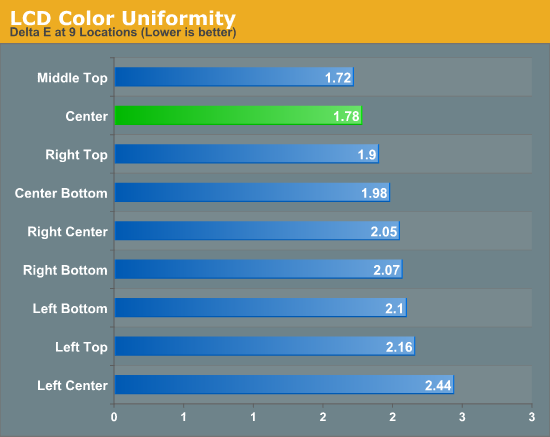
In summary, the uniformity of the Nixeus NX-VUE27 is decent and is similar to what we have seen from other non-professional 27” flat panels. The contrast ratio leaves a good bit to be desired, as the black floor is not what it should be in this display. I could enable the Dynamic Contrast mode to help that, but since it has only one setting and is very noticeable (not in a good way), I wasn’t inclined to enable it.


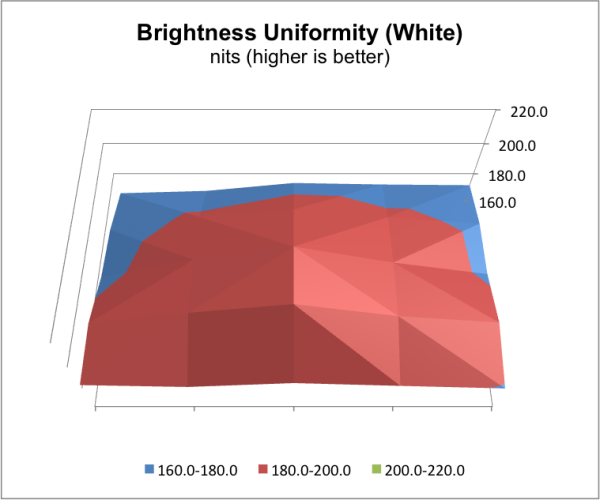
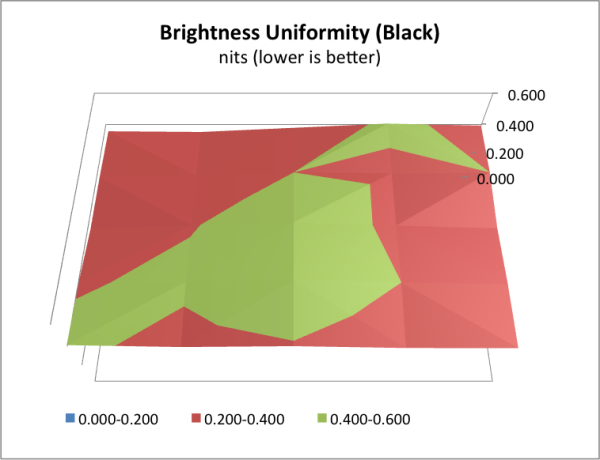
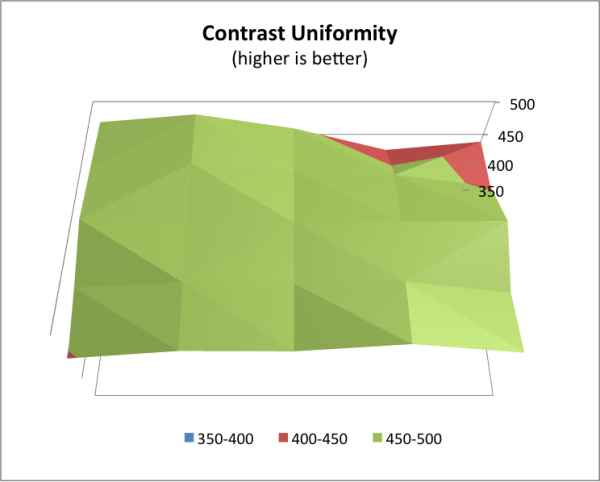
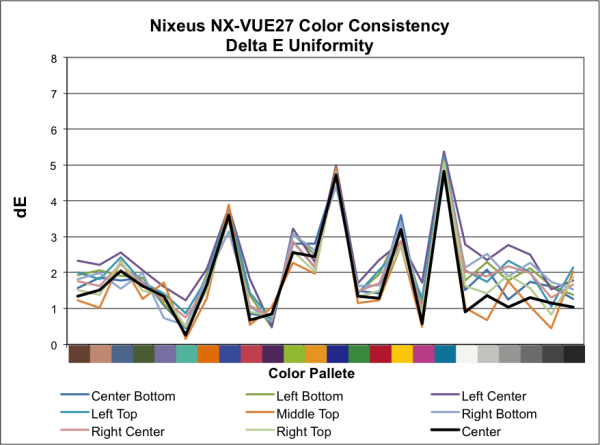
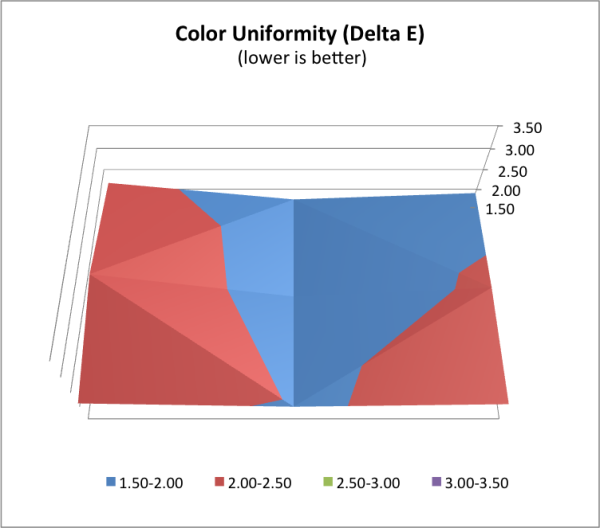








66 Comments
View All Comments
Death666Angel - Friday, September 21, 2012 - link
Or AMD 7xxx. :)Penti - Friday, September 21, 2012 - link
No, just no. Only 3 GHz HDMI 1.4a support above 1920x1200. Don't confuse the two, the monitor does not support it. DVI-DL or DP that rules here. The Nixues might accept a higher res signal over HDMI but it doesn't have the bandwidth to handle it so it causes issues. DP or DVI-DL recommended and is the only one's supported by the vendor. It's basically like trying to run SL-DVI at a higher res then specced here. Skip HDMI-connections whenever you can, skip notebooks with only HDMI whenever you can if you want to run over 1920x1200. Even if you happen to have stuff supporting HDMI 1.4a 3GHz (3GHz part is vital here) in your portable stuff the monitor isn't yet supporting it. They need a new generation of chips driving the displays. GCN and Kepler might be practical if you like to run above 2560x1600 though, but most monitors still requires two DP-connections for 3840x2160/2400 when they don't have true DP1.2 support. There isn't really much of any hardware around to support all the other DP1.2 features either such as daisy chaining.HDMI is essentially useless here unless it can scale your console (1280x720/1920x1080) good enough on that screen to be usable and correctly viewed. VGA isn't really any use either. You simply have to use a lower res screen if you don't have access to DL-DVI and or DP supporting stuff.
atotroadkill - Friday, September 21, 2012 - link
Thanks for the clarification... I currently use the displayport connection from my GTX 670 to my NX-VUE27... before when I was using HDMI 1.4 I did experience artifacts and some sync issues at 2560x1440. After that I tried Dual Link DVI but I couldn't see my bios... but after switching to Displayport those issues went away.Despoiler - Thursday, September 20, 2012 - link
Too much processing lag. 2 FRAMES!!! Glad I held off. That is a non-starter.atotroadkill - Thursday, September 20, 2012 - link
"Because I have to run at a non-standard resolution compared to the Nixeus, you might see some additional lag being added to the input than if you ran natively, but there is no way for me to actually test the native input lag time. There is also no way on the Nixeus to set a 1080p image to be centered and not scaled, which might reduce lag by doing 1:1 mapping and bypassing the scaler but at the expense of only using part of the screen."The 2 Frames and processing is because of Non-Native resolution testing and testing it 1080p...so if you are gaming at 1080p on the monitor then yes it will bother you - and gaming on this monitor at 1080 you shouldn't get this monitor anyways.
I'm using it at 2560x1440 playing BF3 and it has no affect on my shooting and timing (with V-SYNC off)
abhaxus - Friday, September 21, 2012 - link
I wonder about this also. Since the author doesn't have a CRT capable of 1440p for reference, why not just compare the input lag using the HP as a reference at 1440p? Seems like a solution that might get answers for those of us who are quite interested in this monitor. I suspect it's as you say, that without scaling it can do ok.cheinonen - Friday, September 21, 2012 - link
Well, testing that would require that I still have the HP monitor, but since I didn't buy it, that isn't really an option for me to do. The only CRTs out there that can do 1440p are probably projectors with 9" CRTs, and unfortunately installing a 100+ lb. projector, not to mention the cost of finding one in great shape to test it, precludes that.trynberg - Friday, September 21, 2012 - link
Not that I expect you to get one, but there are plenty of 19-21" CRTs out there that can do 2048X1536 resolution for dirt cheap...I have two sitting at home right now (19" Mitsubishi and 21" Sun/Sony).cheinonen - Friday, September 21, 2012 - link
It has to be 2560x1440, though, for the exact same native resolution, and something that can do that is incredibly hard to find.Sabresiberian - Friday, September 21, 2012 - link
Hmm well okay the Sony GDM FW900 runs at 2304x1440, not 2560, but wouldn't that give you better results?(I'm not sure this is a huge issue, as long as your testing methodology is consistent across LCD displays.)